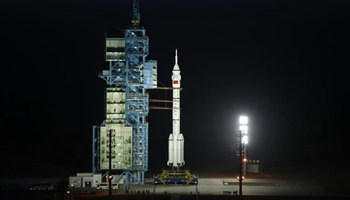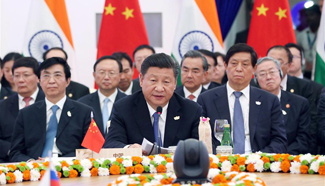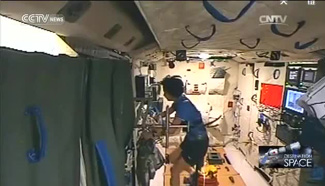Poverty eradication for ethnic minority groups has been accelerated. The government has developed a series of special support policies to accelerate poverty eradication for ethnic minority groups and regions inhabited by ethnic minorities. The Outline for Development-oriented Poverty Reduction for China's Rural Areas (2011-2020) maps out 14 contiguous impoverished areas, 11 of which are in ethnic autonomous areas, and 592 key counties for national development-oriented poverty alleviation work, 263 of which are in ethnic autonomous areas. Of the 30,000 poor villages mapped out in the 12th Five-Year Plan for whole-village development-oriented poverty alleviation, 13,158 are in ethnic autonomous areas. From 2012 to 2015, the central government allocated development funds of RMB14.59 billion for ethnic minority groups to advance a special campaign of developing border areas and improving local people's lives, to support development of ethnic minority groups with a small population, and to protect and develop ethnic minority villages with special features and traditional handicrafts. The central government has worked out a budget to inject RMB5.5 billion to support border areas and areas inhabited by ethnic minority groups with a small population in infrastructure construction, in improving local working and living conditions, and in developing social programs. During the 12th Five-Year Plan period, the impoverished population of the five autonomous regions (Inner Mongolia, Guangxi, Tibet, Ningxia, and Xinjiang) and the three provinces with concentrated ethnic minority groups (Guizhou, Yunnan and Qinghai) had dropped from 39.17 million in 2011 to 18.13 million, a decrease of 21.04 million, down 53.7 percent. The poverty incidence declined from 27.2 percent to 12.4 percent, down by 14.8 percentage points.
Chart: Infrastructure improvement in areas inhabited by ethnic minority groups with a small population
IV. Improving the Development Environment of Impoverished Areas
Strengthening infrastructure construction in impoverished areas to overcome obstacles to development is the basis and premise for realizing local people's rights to subsistence and development. Since 2012, the Chinese government has supported infrastructure construction in impoverished areas with more funds, further improving basic working and living conditions in those areas.
Upgrading and reconstruction of communications infrastructure in impoverished areas has been accelerated. The government issued its "Broadband China" Strategy and Implementation Plan in 2013. The central government has given more financial support to communications infrastructure construction in impoverished areas, and encouraged enterprises to shoulder social responsibilities, so as to eliminate the "digital divide" in poor areas. It has worked hard to promote IT application in poor villages, grant Internet access to towns and townships and broadband access to administrative villages, spread information in the countryside, and do other work. Thus it has effectively improved communications infrastructure in poor rural areas. By the end of 2015, all administrative villages had telephone access, all towns and townships had broadband access, and the number of Internet access ports exceeded 130 million, effectively enhancing broadband penetration in impoverished areas, improving local working and living conditions, and providing strong support to industrial development in those areas. The central government has injected RMB9.22 billion, basically achieving radio and television coverage in all natural villages with a power supply and fewer than 20 households.
Water conservancy in impoverished areas has been intensified. The government has formulated and carried out the Specialized National Plan on Poverty Reduction with Water Conservancy Efforts and more than 10 similar plans or programs, significantly quickening the pace of water conservancy projects in impoverished areas. From 2011 to 2015, 84 percent of central water conservancy funds went to central and western regions, and nearly 70 percent was used in water conservancy projects for improving people's lives. During the 12th Five-Year Plan period, the government arranged RMB237.5 billion of central water conservancy funds for impoverished areas, providing safe drinking water to 115 million rural residents and teachers and students in poor areas, and increasing the provision of centralized water supplies in rural areas to over 75 percent coverage. Among the 85 major water-saving projects under way, 60 will benefit impoverished areas, representing an aggregate of RMB560 billion. In impoverished areas, risks have been mitigated for more than 7,700 dangerous reservoirs and dangerous large and medium-sized sluices, more than 3,900 kilometers of river embankments have been built or reinforced, and 14,500 kilometers of new medium and small rivers have been improved. The installed hydropower capacity of rural areas has grown by 7.5 million kilowatts, providing energy to 440,000 rural households.
Remarkable progress has been made in electric power provision in impoverished areas. From 2013 to 2015, the Chinese government arranged RMB24.8 billion to extend power grids to areas without electricity and launch renewable energy power projects, fully resolving electricity problems for people without power supply services across the country. A rural power grid upgrading campaign has been launched. Both the central and local governments have given more financial support to rural power construction in impoverished areas, especially in remote western ethnic minority regions such as Tibet, Xinjiang and Tibetan-inhabited areas in the four provinces of Sichuan, Yunnan, Qinghai and Gansu. A total of RMB180.2 billion has been allocated to this work, greatly improving the power supply and the universal services in impoverished areas. In 2016, a new round of rural power grid upgrading has been launched.
Transport improvements in impoverished areas have been accelerated. The government has enacted and implemented the Outline on Poverty Reduction with Transportation Construction in Contiguous Impoverished Areas (2011-2020). During the 12th Five-Year Plan period, the government input vehicle purchase tax funds of more than RMB550 billion, and promoted social investment of nearly RMB2 trillion in highway construction. It also accelerated construction of national expressways, general national and provincial highways, rural roads, rural passenger stations, and bridges to replace ropeways in contiguous impoverished areas, building 330,000 kilometers of rural roads, and helping 654 towns and townships, and 48,000 administrative villages to build tarmac and cement roads. By the end of 2015, in contiguous impoverished areas, tarmac and cement roads had been paved in 96.1 percent of towns and townships and 86.2 percent of administrative villages, and shuttle buses served 95.5 percent of towns and townships and 83.1 percent of administrative villages. Improved transport facilities have led to effective development and utilization of mineral resources, energy and tourist potential resources in poor areas, accelerating the pace of poverty eradication. In 2016, China launched a campaign of poverty reduction and eradication involving the construction of one million kilometers of rural roads and 100 major passageway projects.
Living environment of impoverished areas has been improved. The government has launched a project to renovate neglected and dangerous buildings in rural areas, with funds mainly raised by farmers and supplemented by government subsidy. Central finance has increased the subsidy from RMB5,000 to 7,500 per household, and 8,500 for those in impoverished areas, securing the basic housing needs of rural families occupying the most dangerous buildings, and experiencing the greatest financial difficulties. By the end of 2015, a total of RMB155.67 billion had been allocated across the country to support 19.97 million poor rural households in renovating neglected buildings. The government sets ensuring basic sanitary conditions the primary task of improving the living environment of poor villages, and gives preferential support to impoverished areas in protecting traditional villages, and in ensuring rural garbage and sewage treatment facilities. Since 2012, 1,194 villages in impoverished areas have been included in the List of China's Traditional Villages, each of which receives a grant of RMB3 million from central finance to protect the village and improve the living environment. Waste management is improving rapidly in rural areas, and a system of check and acceptance of treatment of rural household refuse in each province has been established, realizing synchronous progress between impoverished areas and other areas.
V. Concerted Efforts in Poverty Reduction
Poverty reduction is a systematic project entailing a set of supporting policies and mechanisms as well as full participation of the entire society. Since 2012 the Chinese government has kept up funding for poverty alleviation and reduction, implemented reforms and innovations to the working mechanism, encouraged all sectors of society to participate in poverty alleviation efforts, and improved the democratic supervision mechanism to ensure the effectiveness of poverty reduction. (more)










